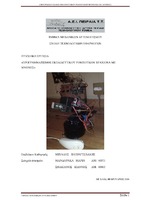Προγραμματισμός εκπαιδευτικού ρομποτικού βραχίονα με μνήμες

Πτυχιακή εργασία
Author
Μανδαράκα, Μαρία
Σφακιανός, Ιωάννης
Date
2016-02Advisor
Παπουτσιδάκης, ΜιχάληςSubject
TPSH::Επιστήμη Υπολογιστών::Επιστήμη Υπολογιστή (Hardware) ; TPSH::Επιστήμη Υπολογιστών::Επιστήμη Υπολογιστή (Software) ; TPSH::Τεχνολογία::Αυτόματος Έλεγχος::ΡομποτικήKeywords
Μνήμες ; Εκπαίδευση ; Ρομποτικός βραχίονας ; Αυτόματος ρομποτικός βραχίοναςAbstract
Η παρούσα πτυχιακή εργασία έχει ως στόχο την εκπαίδευση και εξοικείωση των μαθητών και φοιτητών με την λειτουργία ενός αυτόματου ρομποτικού βραχίονα. Αντιπροσωπεύει τους ρομποτικούς βραχίονες που χρησιμοποιούνται στην βαριά βιομηχανία, όπου ο σωστός χειρισμός και προγραμματισμός τους είναι αναγκαίος, τόσο για την σωστή λειτουργία της βιομηχανίας, όσο και για την ασφάλεια των εργαζομένων. Μετά την εξοικείωση του μαθητευόμενου με τον χώρο λειτουργίας του βραχίονα, και τον χειρισμό του με ασφάλεια, θα είναι σε θέση να τον προγραμματίσει με μεγαλύτερη άνεση. Η χρήση και ο προγραμματισμός του βραχίονα στα σχολεία θα είναι ένα σημαντικό πλεονέκτημα για τους μελλοντικούς φοιτητές, προκειμένου να γνωρίσουν έμπρακτα τον αυτοματισμό για πρώτη φορά με ασφάλεια. Οι φοιτητές θα μπορούν να επαναλάβουν της βασικές αρχές ενός ρομποτικού βραχίονα, και να προβούν σε δυσκολότερες εφαρμογές.
Η λειτουργία χωρίζεται σε δυο μέρη. Το πρώτο μέρος βασίζεται στις μνήμες, προκειμένου να δείξουν στον ενδιαφερόμενο τις δυνατότητες κίνησης του ρομποτικού βραχίονα, σχηματίζοντας συγκεκριμένα σχήματα που επιλέχτηκαν από εμάς, ανάλογα με το ποιο κουμπί (button) έχει επιλέγει. Τα σχήματα αυτά πραγματοποιούνται σε άξονες χ-ψ (x-y) ή σε ψ-ζ (y-z). Επιλέχθηκαν ο κύκλος και η καρδιά ως τα βασικά σχήματα. Ο κύκλος επιλέχθηκε προκείμενου να δείξει ότι ενώ υπάρχουν περιορισμοί στις κινήσεις των σερβοκινητήρων, με τον κατάλληλο κώδικα ο καθένας μπορεί να τους ξεπεράσει. Η καρδιά αντιπροσωπεύει ένα συνδυαστικό σχήμα δυο ημικυκλίων και δυο κάθετων γραμμών, με απώτερο σκοπό να μπορεί ο ενδιαφερόμενος να κατανοήσει ότι μπορεί να δημιουργήσει σχήματα ημιτελή καθώς και παραλληλόγραμμα, ή τριγωνικά. Το keypad περιλαμβάνει και ένα button που πραγματοποιεί ελικοειδή κίνηση (spiral). Αυτή η κίνηση επιλέχθηκε ώστε ο μαθητευόμενος να μπορεί να δει πως μπορεί να προγραμματίσει κινήσεις τριών διαστάσεων χ-ψ-ζ (x-y-z). Η αυτοματοποιημένη λειτουργία χρησιμοποιεί την θεωρία της αντίστροφη κινηματικής, προκείμενου να πραγματοποιήσει της επιθυμητές κινήσεις.Το δεύτερο μέρος αποτελείται από την χειροκίνητη λειτουργία του εν λόγω βραχίονα με το χειριστήριο.
Για την πραγματοποίηση της εφαρμογής χρησιμοποιήθηκε ο ρομποτικός βραχίονας, μοντέλου: 6 DOF Robotic Arm. Ο επεξεργαστής που χρησιμοποιήθηκε στον προγραμματισμό για τις κινήσεις του βραχίονα, είναι το Arduino Mega ADK μέσω του οποίου υπάρχει επικοινωνία με το πληκτρολόγιο (keypad). Κάθε button υποδηλώνει μια πλήρη κίνηση με επιστροφή στην αρχική θέση. Πέρα των αυτοματοποιημένων κινήσεων, το keypad περιλαμβάνει και το button επιλογής της χειροκίνητης λειτουργίας. Για την παύση και την επανεκκίνηση της χειροκίνητης λειτουργίας υπάρχει ένα μαύρο button απομονωμένο από το keypad. Για την άμεση παύση όλης της εφαρμογής υπάρχει το κόκκινο button.Το σύστημα του βραχίονα τροφοδοτείται μέσω του τροφοδοτικού υπολογιστή και ενός κυκλώματος κανονικοποιητή (regulator).
Abstract
The aim of this thesis is to educate and familiarize students of both lower and higher education with the use of an automatic robotic arm. This sample is widely used for industrial purposes; it is essential that these robotic arms are used and programmed carefully, not only to promote their accurate industrial use, but also to ensure the safety of the work force. As soon as one gets better acquainted with the functions and correct handling of the robotic arm, he will be able to control and program it a lot more easily. Furthermore, their use in schools will contribute in introducing a new set of abilities for students to come, helping them come into contact with automation for the very first time. Thereafter, the students in question will be able to replicate the fundamental principles of robotic arms and, more importantly, proceed into more difficult applications.
There are two parts that contribute in the functioning procedure of a robotic arm. The first part is based on memory, which demonstrate the capacities of the robotic arm in terms of movement; they form specific types of shapes depending on which button has been pressed by the operator. These shapes are performed in an axis x-y or y-z. For this study, the two chosen types were a circular and a heart-shaped one. The circle was chosen in an attempt to show that, even though there are certain restrictions in the movements of the servomotors, everyone can overcome them using the appropriate code. The shape of the heart was accomplished through a combinatorial shape of two semi- circles and two vertical lines, which would naturally help the operator in realizing his potential in creating imperfect, parallelogram as well as triangular shapes. The keypad consists of a button that produces spiral movement. This movement was chosen in order for the students to understand how to program three- dimensional movements (x-y-z). This automatic function implicates the theory and equations of inverse kinematics, in order to achieve the intended movements. The second part is mainly associated with the manual function of said robotic arm with the nunchuck.
This practice was carried out by using the 6 DOF Robotic arm. The processor that was applied throughout the programming procedure for the movements of the robotic arm was the Arduino Mega ADK; this model provides a link with the keypad and each button leads to a complete movement and direct return to the initial position. Apart from these automatic movements, the keypad includes a button that allows manual use. In order to pause or restart this manual function, there is also a black button which is isolated from the keypad itself. Furthermore, a red button is also installed in case there is a need for immediate cancellation of the practice. Lastly, the robotic system is fueled by the power supply (of a computer) and a regulator.
Number of pages
53 σελ.Faculty
Σχολή Τεχνολογικών ΕφαρμογώνAcademic Department
Τμήμα Μηχανικών Αυτοματισμού Τ.Ε.Language
GreekCollections
The following license files are associated with this item:

